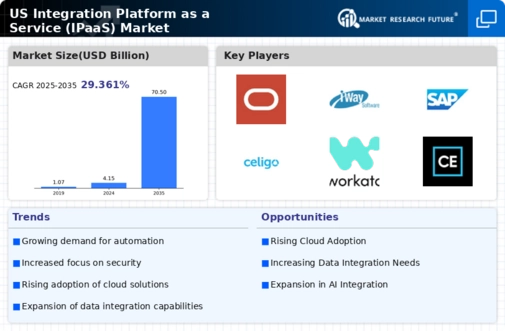The integration platform-as-a-service market is currently characterized by a dynamic competitive landscape, driven by the increasing demand for seamless connectivity and data integration across various applications and systems. Key players such as MuleSoft (US), Dell Boomi (US), and Microsoft (US) are strategically positioning themselves through innovation and partnerships to enhance their service offerings. MuleSoft (US) focuses on expanding its API-led connectivity approach, which allows organizations to integrate applications more efficiently. Meanwhile, Dell Boomi (US) emphasizes its low-code development capabilities, appealing to businesses seeking rapid deployment solutions. Microsoft (US) leverages its Azure cloud platform to integrate its services, thereby enhancing its competitive edge in the market. Collectively, these strategies contribute to a competitive environment that is increasingly centered around technological advancement and customer-centric solutions.
In terms of business tactics, companies are increasingly localizing their operations and optimizing supply chains to respond to market demands more effectively. The integration platform-as-a-service market appears moderately fragmented, with several key players exerting influence over various segments. This structure allows for a diverse range of offerings, enabling businesses to select solutions that best fit their operational needs. The collective influence of these key players fosters a competitive atmosphere where innovation and service differentiation are paramount.
In October 2025, MuleSoft (US) announced a strategic partnership with a leading cloud service provider to enhance its integration capabilities. This collaboration is expected to streamline data flows between cloud applications, thereby improving operational efficiency for clients. The significance of this partnership lies in MuleSoft's ability to leverage the cloud provider's infrastructure, potentially expanding its market reach and enhancing its service portfolio.
In September 2025, Dell Boomi (US) launched a new feature within its platform aimed at improving real-time data integration. This enhancement is particularly relevant for businesses that require immediate access to data for decision-making processes. The strategic importance of this development suggests that Dell Boomi is keen on addressing the growing need for agility in data management, positioning itself as a leader in real-time integration solutions.
In August 2025, Microsoft (US) unveiled an updated version of its integration services, which includes advanced AI capabilities for predictive analytics. This move is indicative of Microsoft's commitment to integrating cutting-edge technology into its offerings, thereby enhancing user experience and operational efficiency. The introduction of AI-driven features may provide Microsoft with a competitive advantage, as businesses increasingly seek intelligent solutions to manage their data.
As of November 2025, current competitive trends in the integration platform-as-a-service market are heavily influenced by digitalization, sustainability, and the integration of AI technologies. Strategic alliances among key players are shaping the landscape, fostering innovation and collaboration. Looking ahead, it is likely that competitive differentiation will evolve, with a shift from price-based competition to a focus on innovation, technology, and supply chain reliability. This transition underscores the importance of developing robust, adaptable solutions that meet the evolving needs of businesses in a rapidly changing environment.
























Leave a Comment